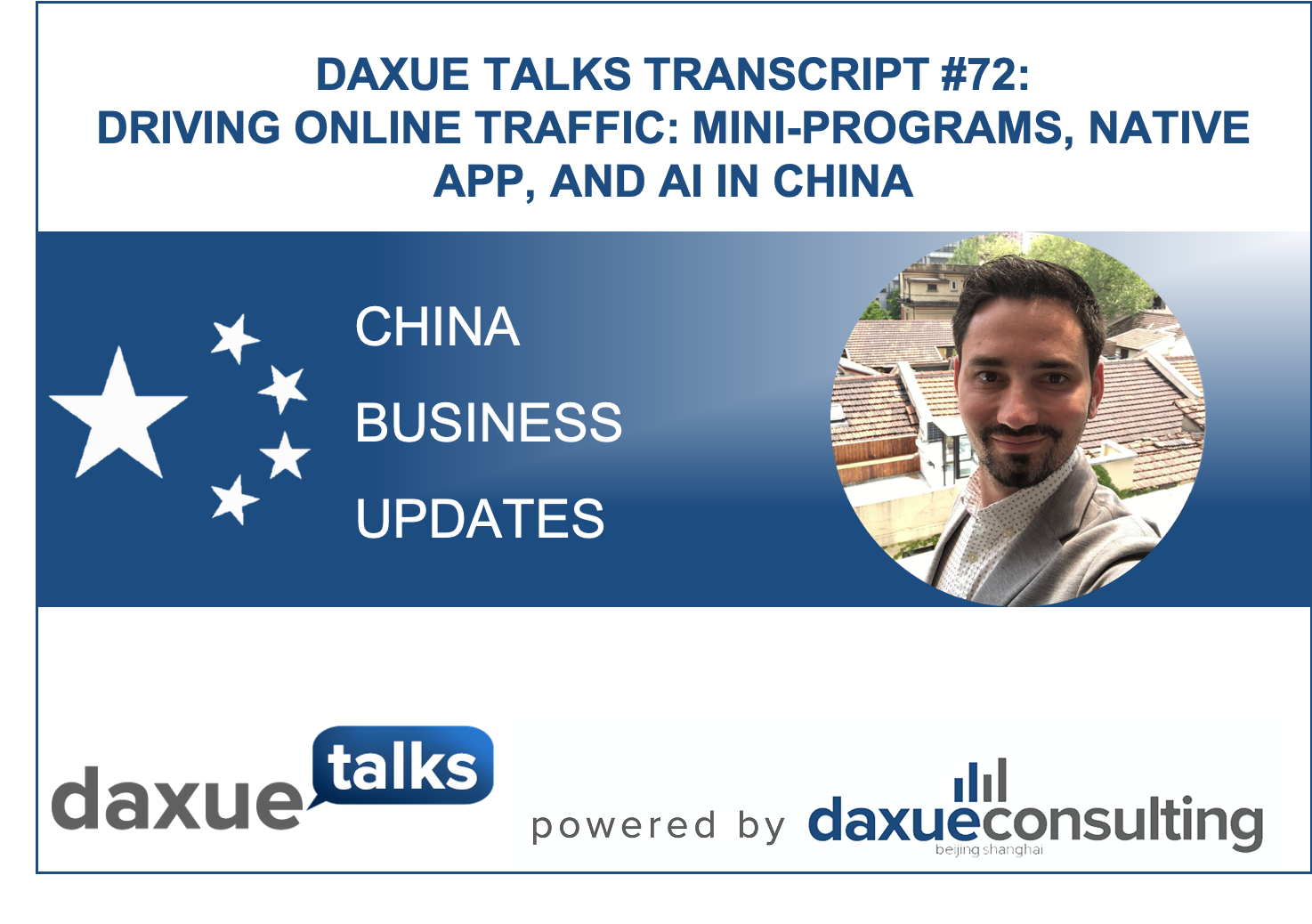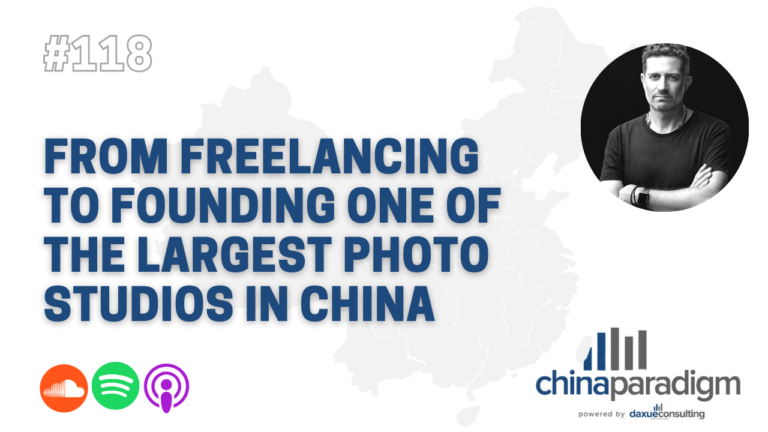Find here Daxue Talks episode 72. In this episode, Aurelien Rigart, Vice President and partner at IT Consultis, explains the different features and functions of mini-programs and the differences with a native app. The focus of this interview is to dive deep into driving online traffic in China.
Full transcript below:
Hello everyone, I’m Aurelien Rigart I’m the co-founder and Vice President of IT Consultis, I’m from France. I’ve been in China and started this adventure nine years ago. So, IT Consultis is a digital transformation company. It’s a team of 80 people in three countries, which are China, Singapore, and Vietnam. So, we’re helping Fortune 500 and fast scaling start-ups to work on their digital transformation. It can range from eCommerce, from building mini-programs, from building websites, App, integrating systems together, or overall work as a consultant on their digital transformation initiatives.
What features and functions can be developed through mini-programs? Can we develop a chatbot, a mini-game, a payment system, a shop, a face recognition, or CR? Also, what can and cannot be implemented through a mini-program?
Well I think the beauty of mini-programs is that you basically can develop almost everything and anything. So, Apple is launching the M version of their mini-programs very soon, so believe it or not – TenCent has launched this revolution and Apply right now is going to follow through, in a couple of weeks. It’s been announced so I think it’s going to be interesting to see how things are moving forward. Once again, coming back to what we were saying, providing the fact that you have like a back-end, but allow your digital transformation to happen, then in the front end you can do everything. If you want to do artificial intelligence related to different price structure, depending on what time of the day you’re booking or depending on the traffic on the platform, you can implement all of this because most of the logic is going to be implemented in the back end and basically the mini-program is just a front end, that is kind of like plugged on it.
So, things that can be implemented on a mini-program that are very popular in China is, of course, loyalty program or referral system because like we’re saying – just like private traffics and those are very – they are isolated, they are kind of like silos and the issues that you have with the silos is that it’s hard to drive the traffic within the silo. So, you want to encourage people to recharge or to purchase on it or to come back to it, so you need to find different ways to make it happen. So, you can find some ways to build social components within your mini-program, or like driving the traffic through a specific KOL or like building some referral program. So, all of this is definitely possible, but the main system, the main function right now of those mini-programs is to really drive traffic for the brands, to have like full ownership and understanding of what their users need.
What features are usable with a native app that you cannot find in a mini-program?
So, I think there are still some limitations when it comes to AR – augmented reality, so WeChat came out with an AR Kit not that long ago. It was not fully necessarily used and now brands are going to start leveraging it. That’s something we’re going to see more and more, especially for new retails. We have a couple of projects with luxury brands working on new retail and how you build AR and how you build O2O experiences, but those are not as advanced as what you can do with the Apple AR for instance, but this is going to follow step by step. But apart from this – like right this moment there is a very little limitation from what you can do with a native app or a mini-program. The only difference is really standing with the user experience, like when you’re on a mini-program, every second you’re going to have your phone vibrating because you’re going to have another conversation taking place somewhere else. So, which means in terms of user experience you’re always going to have the top header and the bottom header that is going to be a little bit different. So in terms of user experience you’re going to be in an area where you very often need to rush, so basically usually what marketers are going to do – they’re going to work on the fear of missing out – in order to drive a purchase or in order to accelerate a conversion because they do understand that the patience of people when they are on a mini-program is going to be more limited than the one that they have on a full app where they’re isolated from the rest – although now you have the opportunity to minimise your mini-program and come back to it afterwards but you’re still multitasking and it’s not the finest experience, but like I’ve seen – people are more and more fully using the mini-program – afterwards if you need to have an app to learn Chinese or to learn English of course you want to isolate yourself and for 20 minutes be somewhere else, and this is where you would need your own app – but like if you’re a luxury brand thinking – oh I need my user to download an app to shop – I don’t think this is necessary, or you need to provide very specific user experience or very specific products to drive the user over there. Otherwise, it doesn’t make sense to do it.
What kind of AI can be implemented within a mini-program and how smart can a mini-program be with what Tencent is offering now?
Well I mean like AI is a very, very broad topic. We don’t – there’s going to be AI a little bit everywhere but like what you see for most of the brands right now, they’re just trying to work on their digital transformation. So, they want to do something that was paper based and they wanted to digitally transform it. So I think in China we are arriving at a period of time which is – like there’s a strong disruption where all companies, all brands – whether they’re B2C, B2B, B2B2c, they do understand that everything that was done on paper right now, they need to digitally transform it. So, the AI is probably going to be really the next layer that is going to come afterwards. Right now, it’s too early. If you’re talking about AI – you can talk about the AI that you have like for example on your booking engine that will calculate the difference price depending on the traffic that you ca have on a specific platform, but that’s not necessarily something that is related to the WeChat mini-program itself. That’s something that is related to all the systems that are created for the booking engine.
Does Tencent offer some AI libraries or building blocks that help you to process intelligence through the mini-programs?
So, I think this is really the early stage – don’t see any requests from any of our clients so – of course, you get the AR that is coming directly natively embedded in your chat system but the latest really strong digital transformation in mini-program has been the live stream. So live stream being made very easily available from the backend and what you can do – for a brand – and we tried it and we’ve done it for a few brands and it’s actually really interesting. Brands just go on the backend and they make a request to WeChat to have their live streaming function. Just a few clicks later you can see yourself and you are broadcasted to the entire world, and that’s the digital transformation and that’s what I know at some point we’re going to talk about 5G – that’s what 5G is allowing. It’s allowing basically everybody tomorrow that is from their home or anywhere, just with a phone – to do live streaming. Because in terms of bandwidths this is taking a lot of bandwidths overall – and what we see is that this technology is made very easy for developers, providing the fact that you have good developers and that they know how to handle the WeChat API and how to navigate it, but I think 2020 – in the beginning of 2020, especially with the Covid happening , a lot of brands have turned to live streaming, but at the same time what they do understand with live stream is that if you want to make it on Ali – then it’s going to be very challenging because once you’ve finished paying TMall and when you finished paying the KOL and then all the subsequent fees, plus the discount you need to make, then in the end you’re making maybe like 25% of the revenues – that’s coming to your bucket – we’re not talking about profit, we’re talking about revenue, so 25 to maybe 60% of the revenue, the rest is going to other people, so it’s a little bit hard for brands to have those live streams and still have the opportunity to make a profit out of it.
Any questions? We will find an expert to answer them. Drop your questions in the comments, or send us an email at dx@daxueconsulting.com.





